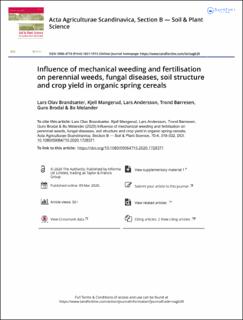| dc.contributor.author | Brandsæter, Lars Olav | |
| dc.contributor.author | Mangerud, Kjell | |
| dc.contributor.author | Andersson, Lars | |
| dc.contributor.author | Børresen, Trond | |
| dc.contributor.author | Brodal, Guro | |
| dc.contributor.author | Melander, Bo | |
| dc.date.accessioned | 2020-11-13T09:16:39Z | |
| dc.date.available | 2020-11-13T09:16:39Z | |
| dc.date.created | 2020-04-21T22:40:36Z | |
| dc.date.issued | 2020 | |
| dc.identifier.citation | Acta Agriculturæ Scandinavica - Section B, Soil and Plant Science. 2020, 70 (4), 318-332. | en_US |
| dc.identifier.issn | 0906-4710 | |
| dc.identifier.uri | https://hdl.handle.net/11250/2687715 | |
| dc.description.abstract | There is a need both in organic farming and on farms using integrated pest management for non-chemical measures that control the perennial weed flora. The effect of mechanical weeding and fertilisation on perennial weeds, fungal diseases and soil structure were evaluated in two different experiments in spring cereals. Experiment I included six strategies. The first strategy was (1) without specific measures against perennial weeds. The other strategies encompassed one or two seasonal control measures; (2) rhizome/root cutting with minimal soil disturbance in autumn, (3) hoeing with 24 cm row spacing, (4) combined hoeing and disc harrowing in autumn, (5) ‘KvikUp’ harrowing in spring, and (6) ‘KvikUp’ harrowing in spring and autumn. Experiment II included factor (i) inter-row hoeing and (ii) fertilisation level. This experiment included the comparison between normal row spacing (12 cm) with weed harrowing versus double row spacing (=24 cm) in combination with inter-row hoeing and 4 fertilisation levels (50–200 kg N ha−1). In experiment I the strategies consisting of no or one direct weed control measure (1, 2, 3 and 5) clearly did not control the perennial weeds. The two seasonal control measures (4 and 6) gave a satisfactory weed control and highest crop yield. The combination of best weed control and no measured harmful effects on soil structure or increase of fungal diseases may explain the highest yields for these strategies. In Experiment II, hoeing and 24 cm spacing gave less perennial biomass compared to 12 cm spacing. Grain yields increased linearly with increasing nitrogen input. The study shows that both inter-row hoeing and weed harrows, are important elements in integrated pest management practice and organic farming. In addition, our results indicate that efficient mechanical weeding is possible without harmful effects in crop rotation consisting of various spring cereals as regards soil structure and plant health. | en_US |
| dc.language.iso | eng | en_US |
| dc.rights | Attribution-NonCommercial-NoDerivatives 4.0 Internasjonal | * |
| dc.rights.uri | http://creativecommons.org/licenses/by-nc-nd/4.0/deed.no | * |
| dc.title | Influence of mechanical weeding and fertilisation on perennial weeds, fungal diseases, soil structure and crop yield in organic spring cereals | en_US |
| dc.type | Peer reviewed | en_US |
| dc.type | Journal article | en_US |
| dc.description.version | publishedVersion | en_US |
| dc.source.pagenumber | 318-332 | en_US |
| dc.source.volume | 70 | en_US |
| dc.source.journal | Acta Agriculturæ Scandinavica - Section B, Soil and Plant Science | en_US |
| dc.source.issue | 4 | en_US |
| dc.identifier.doi | 10.1080/09064710.2020.1728371 | |
| dc.identifier.cristin | 1807422 | |
| dc.relation.project | Norges forskningsråd: 207686 | en_US |
| cristin.ispublished | true | |
| cristin.fulltext | original | |
| cristin.qualitycode | 1 | |

